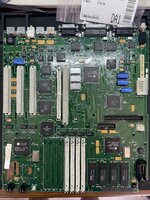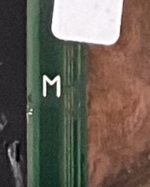jckarter
Member
Hi everyone! I've been trying to bring a IIci back to life that had pretty severe battery and cap damage. It looks like this computer had been stored vertically, but with the battery end high, so battery juice dripped downward through all of the ROMs and SIMM slots. I managed to do all the usual recapping, replace the rusted-out 50MHz crystal and battery holder, get the old SIMM slots desoldered, and cleaned up the crud on the board underneath. Continuity still looks good from the RAM eyelets to the rest of the board. As a checkpoint before soldering in new SIMM sockets, I wanted to see whether I could get the sad Mac chimes, which AIUI should still happen even with no RAM installed. I powered up the board and got silence, and I chalked that up to the ROMs being dead from the battery damage. Sure enough, I grabbed an SE/30 ROM SIMM I had lying around, installed it, pulled off the ROM select jumper, and I got the chimes like expected. So I installed new SIMM sockets in Bank A, threw in some SIMMs and a ROMinator, and…got silence again. But sure enough, when I put the SE/30 ROM in, I get the sad Mac chimes as I did before (which, from reading other threads, sounds like it's expected trying to boot an SE/30 ROM on a IIci, whether there's RAM installed or not).
Now there was a fair amount of corroded solder pads all over the board from the caps in addition to the battery damage, so there could well be other damaged ICs on the board. The fact that the SE/30 ROM is able to give chimes suggests that the CPU and ROM data paths are good, so I'm curious what's different between the SE/30 and IIci ROMs that could cause the latter to fail before it gets to the chimes, to hopefully narrow down where I need to look. AIUI, the IIci ROM and the ROMinator are based on a "universal" ROM with setup code for a bunch of different Macintosh models, so it must need to do some sort of detection to determine which code path to use.
Now there was a fair amount of corroded solder pads all over the board from the caps in addition to the battery damage, so there could well be other damaged ICs on the board. The fact that the SE/30 ROM is able to give chimes suggests that the CPU and ROM data paths are good, so I'm curious what's different between the SE/30 and IIci ROMs that could cause the latter to fail before it gets to the chimes, to hopefully narrow down where I need to look. AIUI, the IIci ROM and the ROMinator are based on a "universal" ROM with setup code for a bunch of different Macintosh models, so it must need to do some sort of detection to determine which code path to use.



